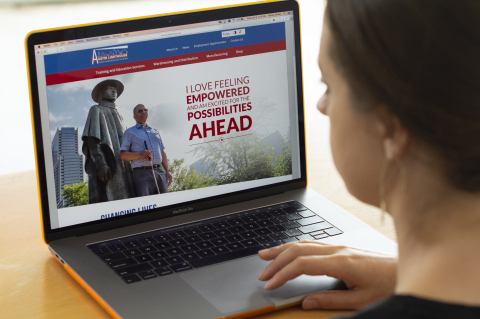The Travis Association for the Blind, commonly referred to as the Austin Lighthouse, launched a new blind-friendly website last week, showing websites can be accessible for both the front end and back end users of a website.
This press release features multimedia. View the full release here: https://www.businesswire.com/news/home/20191009005677/en/

Austin Lighthouse website leads the way for accessibility standards and is usable by the visually impaired in both the front and back end. (Photo: Business Wire)
The new Austin Lighthouse website (www.austinlighthouse.org) went live on Thursday, October 3, just days before the Supreme Court denied a petition from Domino’s Pizza to appeal a lower court ruling in favor of a blind man who sued the pizza chain when he was not able to use their website or mobile app, even with the aid of a screen reader. The decision to uphold the earlier ruling by the 9th U.S. Circuit Court of Appeals will require businesses to employ best practices for making websites accessible to the blind and visually impaired.
“The use of technology is critically important for the blind and visually impaired population,” says Jim Meehan, CEO. “At the Austin Lighthouse, our mission is to serve the blind and visually impaired population, empowering them to live full and independent lives. We just focus on the possibilities and it’s amazing what we can accomplish.”
From mild and moderate to severe and total blindness, visual impairments affect roughly 30,000 people in the Austin and Round Rock area according to the United States Census Bureau and more than 50,000 in Bexar County, according to Nancy Lipton, Public Relations Director for the San Antonio Lighthouse for the Blind and Visually Impaired. Besides difficulty with overall contrast, visual impairments can include difficulty in differentiating colors as well as trouble with clarity and focus with on-screen type and images. Nationally, the American Foundation for the Blind reports that during 2017, up to 65% of legally blind Americans were not employed. Receiving assistance and training through the Austin Lighthouse has helped reduce that rate of unemployment significantly.
The U.S. General Services Administration publishes standards for building accessible websites based on the Section 508 of the Rehabilitation Act. Other organizations such as the World Wide Web Consortium and the ADA have published similar recommendations. The Digital.gov standards are required to be followed by government agencies, and many commercial businesses follow accessibility guidelines to some extent, but this ruling indicates that this will be a requirement for businesses.
Accessibility standards include, among other things, requirements for clear navigation, labeling of images using “alt tags” which provide text on a mouse-hover, and high contrast text to make websites easier to use both with and without assistive technology. Some of the leading screen reader technologies are JAWS, NVDA, and ZoomText, all of which aid in navigation of the website by providing audio descriptions of the text and imagery on the site.
The Austin Lighthouse hired San Antonio firm Robot Creative to design their website with the goal to meet or exceed current accessibility standards. While most website accessibility has been focused on the front end users of the website, Austin Lighthouse also required the website to be accessible to their blind and visually impaired staff on the back end, enabling them to maintain and administer their own website.
“We were surprised to learn that the Austin Lighthouse had legally blind staff who help maintain the website, but we were up for the challenge,” says Lara August, owner of Robot Creative. “We have always approached each site based on the client’s own level of accessibility, but this gives us a new standard. We will certainly be changing how we approach web design based on the current Supreme Court decision.”
About Austin Lighthouse
Travis Association for the Blind (aka Austin Lighthouse), headquartered in Austin, Texas, has been serving the needs of the blind and visually impaired community of Travis County and surrounding areas since 1934. The Lighthouse’s mission is to enhance the opportunities for economic and personal independence of people who are blind or visually impaired by creating, sustaining and improving employment. A 501(c3) nonprofit organization, the Lighthouse does this in several different settings, including warehousing / distribution facilities, manufacturing and repair facilities, assembly operations, bottling operations, custodial, retail and vending operations. By leveraging technology and automation, the Lighthouse employs over 240 people who are legally blind to make the products and provide the services required by their customers. The Lighthouse also works with area business and community partners to assist with developing vocational and independent living skills.
About Robot Creative
For more than two decades, Robot Creative has worked to help regional and national clients to achieve their business goals through powerful branding, strategic marketing and custom website design. Clients from a variety of industries (including technology, real estate, healthcare, nonprofit, retail service, retail product, and professional service) benefit from Robot Creative’s unique blend of research-based design and marketing, an approach that strives to consistently balance outstanding creative work and business logic. To learn more, visit robotcreative.com.
View source version on businesswire.com: https://www.businesswire.com/news/home/20191009005677/en/